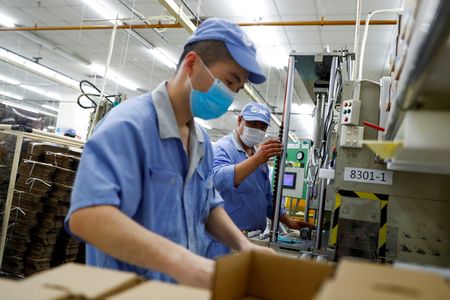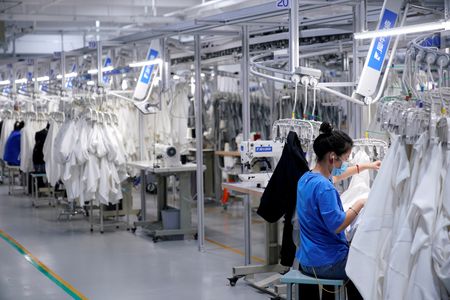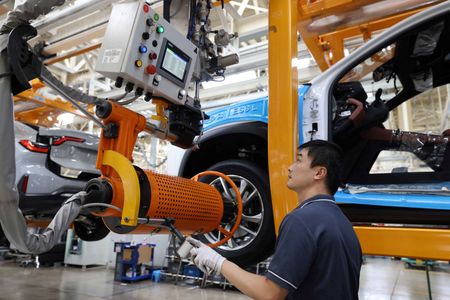BEIJING (Reuters) -China’s factory activity unexpectedly fell in October, weighed by softening global demand and strict domestic COVID-19 curbs, which hit production, travel and shipping in the world’s second-largest economy.
While China’s economic growth beat expectations in the third quarter, persistent COVID-19 curbs, a prolonged property slump and global recession risks are clouding a more robust revival in factory and consumer activity.
The official manufacturing purchasing managers’ index (PMI) fell to 49.2 from 50.1 in September, the National Bureau of Statistics (NBS) said on Monday.
The result unexpectedly broke below the 50-point mark that separates growth from contraction with economists in a Reuters poll forecasting the PMI to have come in at exactly 50.0.
“The official PMIs point to a further loss of momentum in this month as virus disruptions worsened and export orders remained under pressure,” said Zichun Huang, economist at Capital Economics in a research note.
“With the zero-COVID policy here to stay, we think the economy will continue to struggle heading into 2023.”
Separately, the non-manufacturing PMI, which looks at service sector activity, fell to 48.7 from 50.6 in September.
Benchmark mainland Chinese indexes fell after the PMI release.
The offshore yuan fell 0.32% against the dollar but later rose slightly.
As of last week, 31 cities have implemented various levels of lockdowns or some kind of district-based control measures, affecting around 232 million people, Nomura said in a research note.
Economists see China’s current zero-COVID policy as a major economic constraint and expect restrictions to stay in place for some time after this month’s Communist Party Congress.
That has raised concerns that Beijing’s new political leadership could prioritise containing COVID-19 over economic growth.
“We don’t expect the zero-COVID policy to be abandoned until 2024, which means virus disruptions will keep in-person services activity subdued,” said Huang from Capital Economics.
The COVID containment measures are seen disrupting factory output at iPhone maker Foxconn with migrant workers leaving the massive assembly facility in the COVID-hit city of Zhengzhou amid infection worries.
A person with direct knowledge of the matter told Reuters COVID-19 woes at the Zhengzhou plant could slash the site’s November iPhone output by as much as 30%.
Slowing exports, a distressed property market and the yuan’s weakness against the U.S. dollar also weighed on the outlook for the world’s second-biggest economy, Huang added.
Economists expect China will miss its annual growth target of around 5.5%, with the latest Reuters poll forecasting 2022 growth at 3.2%. The poll showed China’s growth could pick up to 5.0% in 2023.
DEMAND WEAKENS
The manufacturing PMI survey pointed to weakening demand with the new orders subindex showing contraction for the fourth straight month.
Manufacturers have grappled with falling external demand, which has been hit by rising interest rates, inflation and the war in Ukraine.
Factories have had to cut their payrolls to reduce costs, adding to worries about the weak labour market, which are weighing heavily on consumption and consumer confidence. The employment index has declined since March 2021.
The official manufacturing PMI largely focuses on big and state-owned firms. The private sector Caixin manufacturing PMI, which centres more on small firms and coastal regions, will be published on Tuesday.
Bruce Pang, chief economist at Jones Lang Lasalle, said China needs to accelerate major projects and expand investment in the fourth quarter, a traditional construction season, in order to stabilise the economy.
(Reporting by Liangping Gao and Ryan Woo; Editing by Sam Holmes)



